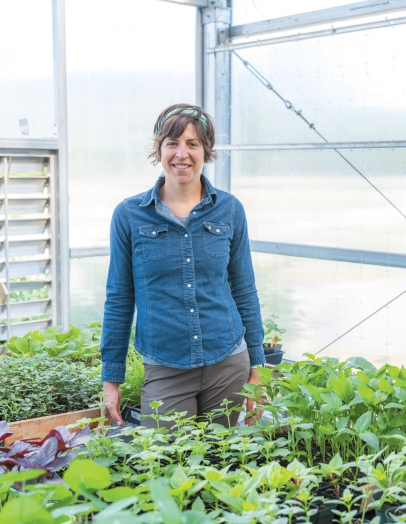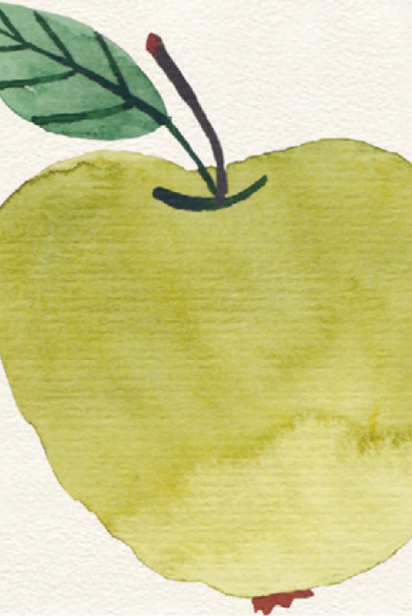Lynn Trizna Executive Director, Pitney Meadows Community Farm
Drive along West Road in Saratoga Springs, just a stone’s throw from the bustling Route 50, and you’ll see a bucolic vision: lush pasture and 15 acres of vegetable gardens behind a well-maintained white horse fence. Crisp white barns, outbuildings and greenhouses dot the landscape. This flat, sandy terrain that had been the Albany Beach centuries ago now supports 166 acres of fields, forests and wetlands, with a focus on continually improving soil health and maintaining diverse natural habitats. Welcome to the magic of Pitney Meadows Community Farm, an urban farm that welcomes—and educates—all.
Maria Buteux Reade: Tell me a bit of the farm’s history.
Lynn Trizna: The Pitney family established this 166-acre property in 1862 as a dairy and crop farm. They started Thorobred Feed in 1958, and Bill Pitney used to drive his tractor loaded with a hay wagon from the farm to Saratoga Race Course to provide feed for the horses there. He sure couldn’t do that today! The family had been approached by developers for years, but they really wanted to see the land remain in agriculture.
And how did Pitney Meadows come to be?
A number of forces combined to make this happen. We purchased the land in 2013 with taxpayer money and funding from the Open Space Project and the Bond Act. We incorporated in 2016 to create this community farm. The land now must be used for agriculture and recreation.
What type of programming do you oversee?
Education is the backbone of all that we do. We want to bring people to the farm and connect them with the land and their food. We have community garden beds, a designated children’s garden with vibrant kids’ programs, a pick-your-own CSA (community-supported agriculture), a farm stand that’s open to the public, cooking and composting classes and a variety of educational events. We started a program called Community Supported Conversations, with an anchoring theme of stewardship of land, soil and water. Stewarding our natural resources here at Pitney Meadows and for people at home requires a collective effort. Imagine the impact if more and more people learned how to compost correctly, eat a seasonal diet, support local farmers and pay more attention to our water usage!
Tell me about the community garden.
We have more than 125 beds in several sizes. Those are on a sliding-scale payment option, from several hundred dollars to zero, based on a member’s ability to pay. People who can afford to pay more often do so to help offset the fee for others who may not be able to pay as much. We currently have a waiting list. The garden is incredibly popular because even if you’re working solo in your plot, there’s other people around and you can enjoy a sense of community.
What does a membership include?
People get access to seeds, tools, soil amendments and compost as well as guidance from Joyce Carroll, our community garden director. And if even if you don’t tend a bed, you can still participate in our demonstration garden workshops. Many people come here to learn the basics, and once equipped with that knowledge and confidence, they often start a garden at home.
And how about the children’s garden?
That’s new this summer. We created a 30- by 30-foot bed in the back sector designed for kids’ programs, right next to the Fairy Garden. There’s a sensory garden with herbs and flowers to engage smell, touch and taste. We have designed an exploration garden, a rain garden, a pumpkin “sea” and a kids’ greenhouse for season-extension activities, which will be created and installed in the next few years.
How does the pick-your-own CSA work?
We have 125 members. As part of that membership, we have an orientation where our crew teaches people how to properly harvest the crops we grow, such as beans, tomatoes, peppers, summer squash, cukes, onions, broccoli and flowers. Being able to interact with staff who can help is especially important for someone new to gardening and harvesting. We also have guided pick-your-own events on weekends where non-members can pay for the experience and the produce they harvest. It’s been a great way for someone to test it out even if they’re just visiting.
Is the farm stand near the entrance open to the public? And what products do you carry?
Yes! The public still thinks we’re a private farm and we’re working to change that perception. At the stand, visitors can connect with a staff member who can answer questions about the produce and the farm. Flyers and websites are great, but nothing can replace this human interaction.
We stock the shop with goods from 15 other area farms, things we don’t produce, such as meat, eggs, certain produce, vinegar and pickles. We don’t want to compete with the local farm economy; we want to enhance it. We see ourselves as the gateway to supporting local farms and farmers’ markets.
What happens with the rest of the produce your farmers grow?
During COVID, we ramped up our food-security efforts. We donated 6,000 pounds in 2019, and that number skyrocketed to 23,000 pounds in 2020. We loaded our trucks and drove them over to the Capital Region Foodbank, and they handled distribution.
But last year, we wanted to find ways to increase our impact without scaling up the volume. We couldn’t sustain that exponential growth so we partnered with different organizations such as meal aggregate sites and social service agencies. By being strategic with our resources, we could benefit those who weren’t being served in a way they needed. We realized that we’re great at growing food, but let’s focus on community partners who can best identify where the needs are and handle distribution.
What are some events you host at the farm?
We offer a Community Forum each year in which we educate about what we’re doing, but we also want to hear from the public what they would like to see or experience here. In July, we hold a Fire Feast with local celebrity chefs cooking over open-flame fire pits. That’s a ticketed event that serves as our annual fundraiser. We stage a 0.5 “Race,” which is a fun mini-run or walk where folks show up in costumes and maybe dress up their dogs. It’s a fundraiser to benefit two of our community partners, Shelters of Saratoga and Habitat for Humanity. And then in autumn, we hold Jump into Fall, a farm-based festival with the Waldorf School that offers educational programs and workshops. Other than the Fire Feast, these events are free or low cost and open to the public.
I see you have a lovely walking trail that meanders through the farm fields. How did that come to be?
Since we used taxpayer money to fund part of this purchase in 2013, we offer recreation opportunities to the public. We weren’t going to turn farmland into soccer fields, so we created a 1.7-mile gravel walking path that loops through the farm and allows people to see daily life on a working farm. It’s quite popular.
Do you have any connection with Saratoga High School across the road?
We sure do! The boys and girls cross-country teams run through the premises during practice, and in exchange, the boys serve as parking attendants at all our events. They’re definitely a crowd pleaser! And we provide opportunities for high-school students who need community service hours to do some work here.
How about your staff?
We’ve evolved from being an organization run largely by engaged board members and volunteers to employing a full-time staff of nine plus a summer farm crew. Ian Magnus is our farm manager; Sarah Miles serves as education director; and Joyce Carroll manages the community garden. And we are eternally grateful to Bill Pitney who continues to do so much for us. He and his family started this vision back in 1862, and he’s our general caretaker and still comes to the farm every day.
Tell me about your own farming background.
I came to farming almost by accident. A friend had told me about WWOOF-ing (World-Wide Opportunities for Organic Farming) as a cheap way to travel. I started to volunteer on a farm during my freshman year at the University of Pittsburgh. One of the interns developed carpal tunnel so the farm manager hired me for that summer.
So how did you land here in Saratoga?
After college, I worked at for-profit and nonprofit farms for years. I started a farm-to-hospital project in Bethlehem, Pennsylvania, for the Rodale Institute. At some point, I realized I was looking for more community engagement. So I found this executive director role at Pitney Meadows in the summer of 2020, got the job and arrived in September 2020. This position and farm have everything I’d been looking for.
Nearly two years in, what inspires you day to day?
Seeing people here on the property—in the community gardens, on the walking trail or stopping by the farm stand. Having the opportunity to meet folks whom we attract and to witness the impact we’re having. Pitney Meadows brings people of all ages and from all walks of life onto the same playing field, all connected through love of gardening and good food.
I suspect that it’s hard to transition from having your hands in the soil to serving in an administrative role. How do you deal with that change of pace?
You’re absolutely right. Farming calmed me, and I loved the sheer physicality of the work. I also played roller derby to release any aggression! Now, my husband, Riley, and I spend our weekends working in our quarter-acre garden at home, chopping firewood and tackling house projects. We cook everything from scratch, too. Oh yeah, and I started riding a motorcycle! So yes, I miss the actual farming work, but I love being able to empower and enable so many people to grow healthy food.
Pitneymeadowscommunityfarm.org
FIVE RAPID FIRE
Breakfast today?
Cheerios, which I bring here and eat when I have the time.
Favorite childhood meal?
(At this, Lynn bursts into sheepish laughter but has an immediate response.) Hamburger gravy. My mom would cook a chunk of hamburger with onions, flour and milk and serve it over mashed potatoes. I’m a vegetable monster now so this is not a good representation of my current eating habits!
Cake, pie or cookies?
Chocolate oatmeal cookies.
Guilty pleasure in food or drink?
Drink: I’m highly caffeinated at all times but don’t feel guilty about it. Food: If you can call it food, it’s whipped cream from a can. On pie, a couple times a year.
Late-night snack?
An apple. Maybe that balances the whipped cream.





